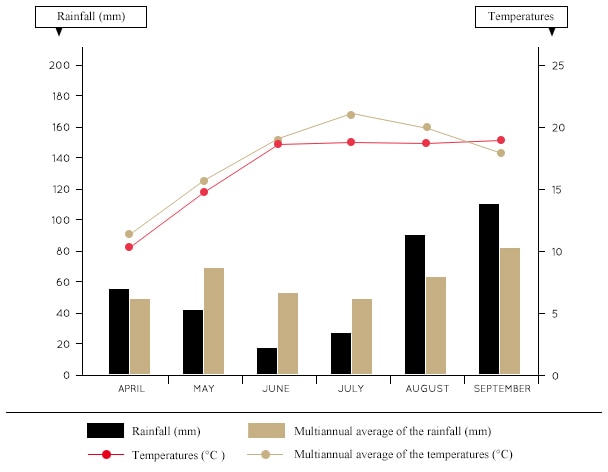

1954 was unfortunately a poor year due to very cool, wet weather. The grapes never fully ripened, and the juice was barely rosé-coloured. However, this was a benchmark year for Saint Emilion because it was when the first classification was made. The supreme honour went to Cheval Blanc, who shared the category of Premier Grand Cru Classé A with Ausone.


1954 was unfortunately a poor year due to very cool, wet weather. The grapes never fully ripened, and the juice was barely rosé-coloured. However, this was a benchmark year for Saint Emilion because it was when the first classification was made. The supreme honour went to Cheval Blanc, who shared the category of Premier Grand Cru Classé A with Ausone.
Weather conditions and vine’s growing cycle
Temperatures and rainfall
The first four months of the growing season were cool, but not very wet. August, on the other hand, was both very cool and wet. The showers continued into September, while temperatures were above average.

Water balance
In order to grow well, the vine needs for water stress to set in slowly so the grapes to ripen well and become concentrated. Moderate water stress developed in July, but the soil’s water reserves were partly reconstituted in August and September.

Growing season
The cold summer of 1954 significantly delayed phenolic maturity. The harvest began on the 5th of October in the rain. With a yield of 31 hectolitres per hectare, the grapes looked more like currants, and were attacked by rot that had nothing whatsoever noble about it!
Degree of alcohol: 14°.
| Begin | End | |
| 1954 harvest dates | October, 5th | October, 20th |
| Average harvest dates: 1946-2014 | September, 24th | October, 8th |
Features of the vintage
Ripening and yields
| 1954 yield (hl/ha) | Average yield (1946 to 2014) | |
| 31.0 | 33.9 | |
Tasting
 The relatively smoky nose is still fresh, and opens on hay and straw.
The mouth bears an important level of acidity. The light structure lacks a bit of length.
The relatively smoky nose is still fresh, and opens on hay and straw.
The mouth bears an important level of acidity. The light structure lacks a bit of length. As opposed to the remarkably cooperative weather in 1953, conditions in 1954 were far from ideal. In fact, the weather throughout the growing season can be summed up in three words: cold, wet, and misty. It was necessary to light smudge pots at the end of the vine rows during the harvest, which took place from the 5th to the 20th of October. The grapes had high sugar levels (the wine contains 14° alcohol), but were often rotten.
The wine is barely pink in colour and should not be sought out.
As opposed to the remarkably cooperative weather in 1953, conditions in 1954 were far from ideal. In fact, the weather throughout the growing season can be summed up in three words: cold, wet, and misty. It was necessary to light smudge pots at the end of the vine rows during the harvest, which took place from the 5th to the 20th of October. The grapes had high sugar levels (the wine contains 14° alcohol), but were often rotten.
The wine is barely pink in colour and should not be sought out.The relatively smoky nose is still fresh, and opens on hay and straw.
The mouth bears an important level of acidity. The light structure lacks a bit of length.
As opposed to the remarkably cooperative weather in 1953, conditions in 1954 were far from ideal. In fact, the weather throughout the growing season can be summed up in three words: cold, wet, and misty. It was necessary to light smudge pots at the end of the vine rows during the harvest, which took place from the 5th to the 20th of October. The grapes had high sugar levels (the wine contains 14° alcohol), but were often rotten.
The wine is barely pink in colour and should not be sought out.



